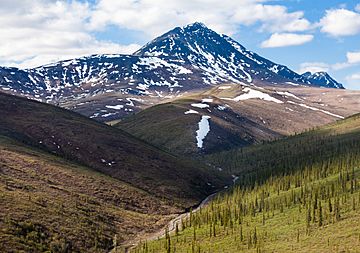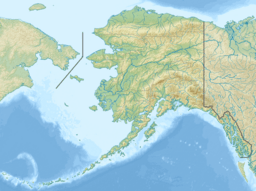Poss Mountain facts for kids
Quick facts for kids Poss Mountain |
|
|---|---|

Poss Mountain above Gold Creek, north aspect
|
|
| Highest point | |
| Elevation | 6,180 ft (1,880 m) |
| Prominence | 4,380 ft (1,340 m) |
| Isolation | 23.2 mi (37.3 km) |
| Parent peak | Peak 6450 |
| Geography | |
| Location | Yukon–Koyukuk Alaska, United States |
| Parent range | Philip Smith Mountains Brooks Range |
| Topo map | USGS Chandalar B-6 |
Poss Mountain is a tall mountain in Alaska, standing 6,180 feet (about 1,880 meters) high. It is part of the Philip Smith Mountains, which are in the Brooks Range. This mountain is located far north, about 80 miles (129 km) above the Arctic Circle.
The mountain got its name around 1930. A wilderness explorer named Robert Marshall named it after an old gold miner. The miner's name was "Poss" Postlethwaite. He was one of the first gold prospectors in the area near Wiseman.
Robert Marshall said that Poss Postlethwaite was 78 years old at the time. He had spent 32 winters living in the Koyukuk area. The name "Poss Mountain" became official in 1932.
A special area called the Poss Mountain Research Natural Area was created in 1991. This area covers about 8,042 acres (3,255 hectares). It helps protect natural mineral licks, which are places where animals can get important minerals. It also protects areas where Dall sheep have their babies.
Water from Poss Mountain flows into streams that lead to the Middle and South Forks of the Koyukuk River.
Weather at Poss Mountain
The weather around Poss Mountain is very cold for most of the year. It has a subarctic climate. This means winters are long and very cold, while summers are short and cool.
Temperatures can drop below -30 °C (-22 °F). With the wind, it can feel even colder, sometimes below -50 °C (-58 °F). The best time to visit or climb the mountain is usually from June to August. These months have the most pleasant weather.


